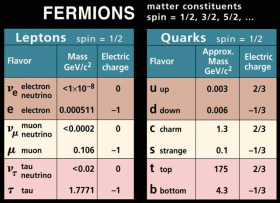
![]()
Introduction of Elementary Particles
Until its development in the third decade of the 20th century, the scientific
atomic theory did not differ philosophically very much from that of Dalton,
although at first sight the difference may appear large. Dalton's atoms
were no longer considered to be immutable and indivisible; new elementary
particles sometimes appeared on the scene; and molecules were no longer
seen as a mere juxtaposition of atoms--when entering into a compound atoms
became ions. Yet, these differences were only accidental; the atoms revealed
themselves as composed of more elementary particles--protons,
neutrons, and electrons--but these particles themselves were considered
then as immutable. Thus the general picture remained the same. The material
world was still thought to be composed of smallest particles, which differed
in nature and which in certain definite ways could form relatively stable
structures (atoms). These structures were able to form new combinations
(molecules) by exchanging certain component parts (electrons). The whole
process was ruled by well-known mechanical and electrodynamic laws.
In contemporary atomic theory the differences from Dalton are much more
fundamental. The hypothesis of the existence of immutable elementary particles
has been abandoned: elementary particles can be transformed into radiation
and vice versa. And when they combine into greater units, the particles
do not necessarily preserve their identity; they can be absorbed into
a greater whole.
Two Types of Particles
The two most fundamental types of particles are quarks
and leptons. The quarks and leptons
are divided into 6 flavors corresponding to three generations of matter.
Quarks (and antiquarks) have electric charges in units of 1/3 or 2/3's.
Leptons have charges in units of 1 or 0.

Note that for every quark or lepton there is a corresponding antiparticle.
For example, there is an up antiquark, an anti-electron (called a positron)
and an anti-neutrino. Bosons do not have antiparticles since they are
force carriers
Fundamental Forces :
Matter is effected by forces or interactions (the terms are interchangeable).
There are four fundamental forces in the Universe:
1.gravitation (between particles with mass)
2.electromagnetic (between particles with
charge/magnetism)
3.strong nuclear force (between quarks)
4.weak nuclear force (operates between neutrinos
and electrons)
What are the effects when particles interact with Photons or Gluons in
the electromagnetic force is the purpose of this project.